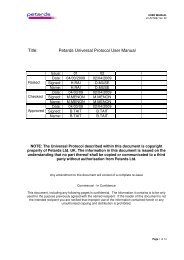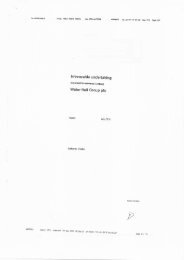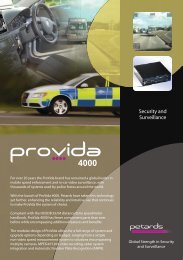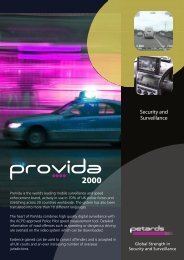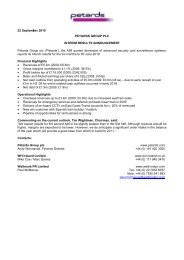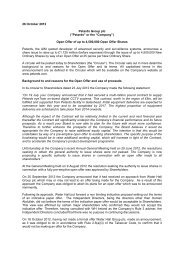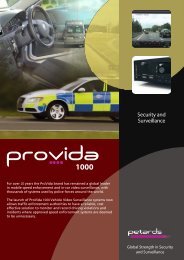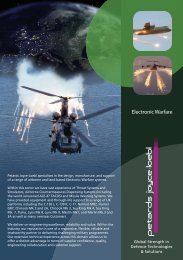Annual Report and Accounts 2012 - Petards Group plc
Annual Report and Accounts 2012 - Petards Group plc
Annual Report and Accounts 2012 - Petards Group plc
You also want an ePaper? Increase the reach of your titles
YUMPU automatically turns print PDFs into web optimized ePapers that Google loves.
Notes<br />
(forming part of the financial statements) (continued)<br />
1. Accounting policies (continued)<br />
Property, plant <strong>and</strong> equipment<br />
Property, plant <strong>and</strong> equipment are stated at cost less accumulated depreciation <strong>and</strong> impairment losses.<br />
Where parts of an item of property, plant <strong>and</strong> equipment have different useful lives, they are accounted for as separate items of property,<br />
plant <strong>and</strong> equipment.<br />
Leases in which the <strong>Group</strong> assumes substantially all the risks <strong>and</strong> rewards of ownership of the leased asset are classified as finance leases.<br />
Leased assets acquired by way of finance lease are stated at an amount equal to the lower of their fair value <strong>and</strong> the present value of the<br />
minimum lease payments at inception of the lease, less accumulated depreciation <strong>and</strong> impairment losses.<br />
Depreciation is charged to the income statement on a straight line basis over the estimated useful lives of each part of an item of property,<br />
plant <strong>and</strong> equipment. L<strong>and</strong> is not depreciated. The estimated useful lives are as follows:<br />
Leasehold improvements<br />
Plant <strong>and</strong> equipment:<br />
Plant <strong>and</strong> equipment<br />
Computer equipment<br />
Furniture <strong>and</strong> fittings<br />
Motor vehicles<br />
life of lease straight line<br />
3-10 years<br />
3-5 years<br />
3-5 years<br />
4-5 years<br />
The residual value <strong>and</strong> useful economic life are reassessed annually.<br />
Intangible assets <strong>and</strong> goodwill<br />
Goodwill is stated at cost less any accumulated impairment losses. Goodwill is allocated to cash generating units <strong>and</strong> is not amortised but<br />
is tested annually for impairment.<br />
Business combinations are accounted for by applying the purchase method. Goodwill represents amounts arising on acquisition of<br />
subsidiaries. In respect of business acquisitions that have occurred since 1 January 2006, goodwill represents the difference between the<br />
cost of the acquisition <strong>and</strong> the net fair value of the identifiable assets, liabilities <strong>and</strong> contingent liabilities acquired. Identifiable intangibles<br />
are those which can be sold separately or which arise from legal rights regardless of whether those rights are separable.<br />
IFRS 1 grants certain exemptions from the full requirements of Adopted IFRSs in the transition period. The <strong>Group</strong> elected not to restate<br />
business combinations that took place prior to transition date. In respect of acquisitions prior to 1 January 2006, goodwill is included at<br />
transition date on the basis of its deemed cost, which represents the amount recorded under UK GAAP.<br />
Other intangible assets that are acquired by the <strong>Group</strong> are stated at cost less accumulated amortisation <strong>and</strong> impairment losses.<br />
Amortisation is charged on a straight line basis over the estimated useful lives of intangible assets. Other intangible assets are amortised<br />
from the date they are available for use.<br />
Research <strong>and</strong> development<br />
Expenditure on research activities is recognised as an expense in the period in which it is incurred.<br />
Expenditure on activities for the development of new or substantially improved products is capitalised if the product is technically <strong>and</strong><br />
commercially feasible, <strong>and</strong> the <strong>Group</strong> has the technical ability <strong>and</strong> has sufficient resources to complete development <strong>and</strong> if the <strong>Group</strong> can<br />
measure reliably the expenditure attributable to the intangible asset during its development. The expenditure capitalised includes the cost<br />
of materials, direct labour <strong>and</strong> an appropriate proportion of overheads. Development expenditure not meeting the above criteria is<br />
recognised in the income statement as an expense as incurred. Capitalised development expenditure is stated at cost less accumulated<br />
amortisation <strong>and</strong> impairment losses.<br />
Contract related development costs are accounted for as part of the cost of the contract <strong>and</strong> are not capitalised.<br />
Internally generated development expenditure is amortised on a straight-line basis over the period which Directors expect to obtain<br />
economic benefits (3 to 5 years from asset being available for use). Where no internally generated intangible asset can be recognised,<br />
development expenditure is recognised as an expense in the period in which it is incurred.<br />
18





